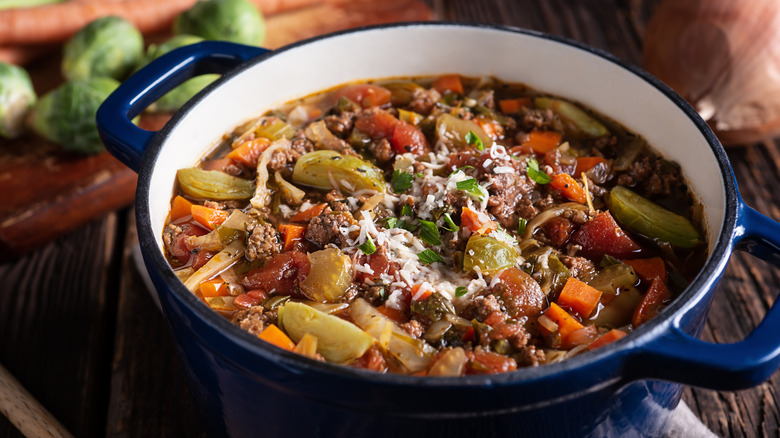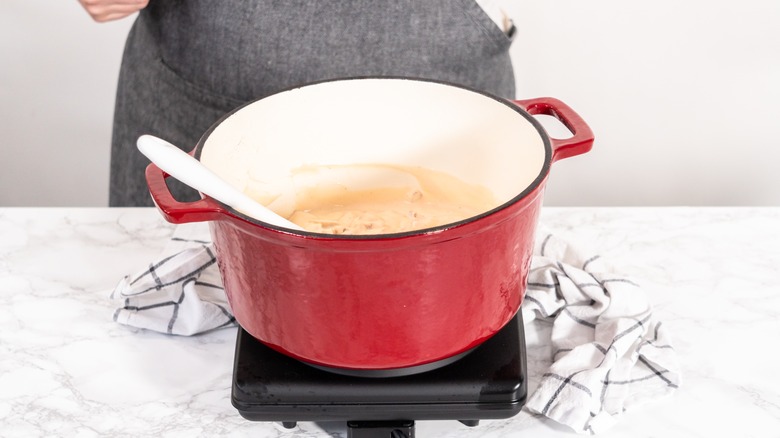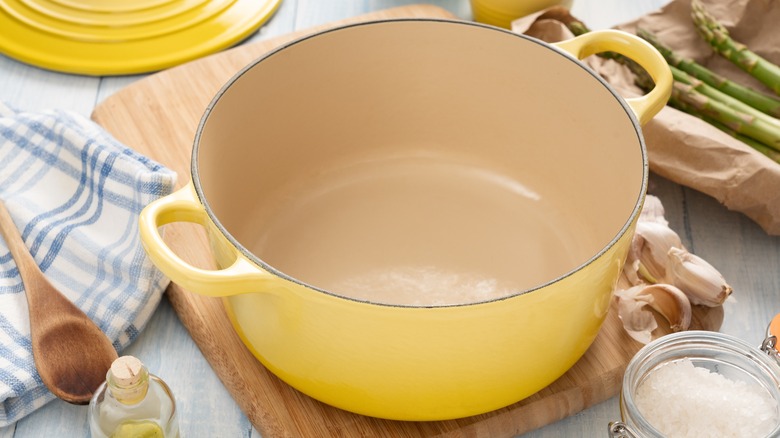The Dutch Oven Cleaning Mistake To Avoid For A Rust-Free Pot
Whether you're a serious, experienced cook or a newbie just starting, arguably one of the most important pieces of equipment to have in your kitchen is a Dutch oven. These large, enameled, cast iron pots can be used for everything from making a big batch of soup or stew to frying chicken. A high-quality Dutch oven can be a big investment in almost any kitchen, which is why they tend to show up on wedding registries and other wish lists. The tradeoff for shelling out hundreds of dollars for a pricey piece of cookware is that it will last a lifetime if you take care of it properly.
Although Dutch ovens are designed to be versatile and extremely durable, they are not without their faults, especially when it comes to cleaning. If you're using your Dutch oven regularly, there's no way to avoid getting a few stains and burned bits on the pot from time to time. If you're left with some blackened spots after you make a batch of beef stew, resist the urge to reach for steel wool to shift those bits. The enamel surrounding the cast iron is bonded to the iron, but it's not impervious to scratches from sharp utensils and harsh scrubbing. Think of the surface of your Dutch oven like the surface of your teeth — you wouldn't clean your stained teeth with a wire brush, and the same is true for your precious pot.
Soak, don't scrub
Because Dutch ovens can be susceptible to damage from abrasives, don't make the mistake of using anything overly abrasive to scrub away stains left in your Dutch oven after cooking. Metal scrubbers and steel wool can remove more than just the stuck-on food — they can scrape away the enamel. Once the enamel is scratched, the cast iron underneath is exposed, leaving your pot vulnerable to rust. Even some types of cleansers, such as Bar Keeper's Friend, Comet, and other powders, can be too abrasive and damage the surface of your Dutch oven. Lemon-based cleansers can also make enamel look dull, according to the cast iron experts at Lodge.
Most of the time, stubborn stains and stuck-on goo will come off the enamel cooking surface of your pot if you just give it some time to soak in hot water with a squirt of regular dish soap for a few hours before scrubbing it again with a nylon sponge. If the stuck-on stuff still won't come off, one of the best ways to clean enamel cookware involves using a sprinkling of baking soda as either a wet or dry scrub to work things loose.
If you must scrub on your Dutch oven, be sure to always wash yours with a gentle cleanser. If you must scrub, only use a nylon scrub brush, scouring pad, or sponge.
Boil the bits away
If the browned bits on the bottom of your Dutch oven will not budge even after soaking and scrubbing with a little baking soda, all is not lost. Lodge recommends boiling a mixture of 2 cups of water with 4 tablespoons of baking soda to loosen anything that's stuck to the inside of your pot. After you've let the mixture boil for five or 10 minutes, turn off the heat and let the water cool, dump everything out and use a pan scraper to loosen whatever is stuck to the bottom of the pan. This should remove almost any stubborn spots, but if things are still sticking you can repeat the process until everything comes off. When the pot is all clean, make sure to dry it thoroughly before putting it away to prevent any rust from forming on the rim.
Don't go overboard trying to clean every stain off of your Dutch oven, either. Unless you're dealing with stuck-on food, a few stains on the patina are normal and it's a sign that your cookware is used a lot. Just be sure to keep the surface clean of food with the proper cleaning and scrubbing, and leave the day-to-day stains as a sign of a well-loved kitchen workhorse.


